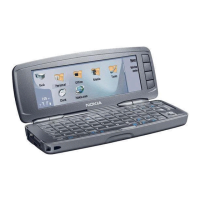To add a document, sheet or image to a fax, press Insert
object. Note that it may not always be possible to insert
a document to a fax. If you want to send a document as
a fax, use the File > Send > Via fax option in Documents.
To print a fax, press Menu, and select File > Printing >
Print.... Check that the printing settings are correct, and
press Print.
To view a received fax, select the fax, and press Open.
Press the arrow keys to scroll the fax.
To rotate a fax, press Rotate.
To zoom in or out, press Zoom in or Zoom out.
Saving a received fax
In the Range selection dialog, you can select the section
of the fax you want to export to another picture file
format.
To save a multipage fax, open the fax, press Menu, and
select File > Export.... Select Whole document to save the
fax as a whole, Current page to save the page you are on,
Selected to save a section that you selected, or User
defined: to enter the page numbers of the pages you want
to save.
Editing fax settings
Press Menu, and select Tools > Account settings.... Select
Fax, and press Edit.
On the General page, define the following:
• Fax cover page — Select whether to use a header or
cover page for a fax. Select Template 1 to create a
separate cover page, Full template to use a cover page
that includes all the contact information of both the
sender and the recipient, your remarks on the fax
content, and the date, Header to display the sender and
the recipient information and the date, or None for no
cover page.
• Send fax — Select when to send the messages. If you
select Upon request, you must select a message in
Outbox, and send the fax from there.
On the Advanced page, define the following:
• Resolution — Select the resolution for your sent and
received faxes.
• ECM — Select whether erroneous fax pages are
automatically corrected during sending. Note that also
the receiving device has to support ECM.
• Resend — Select whether to resend All pages or only
the Missed pages if any fax pages failed to be sent.
To edit settings for fax diverting or fax barring, press Fax
diverting or Fax barring.
Special message types
The device can receive different types of messages, for
example, text messages that contain data, operator logos,
ringing tones, bookmarks, or Internet access or e-mail
account settings.
The device can also receive service messages. Service
messages are notifications of, for example, news
headlines and may contain a text message or a link. For
availability and subscription, contact your service
provider.
50
Messaging
Cyan

